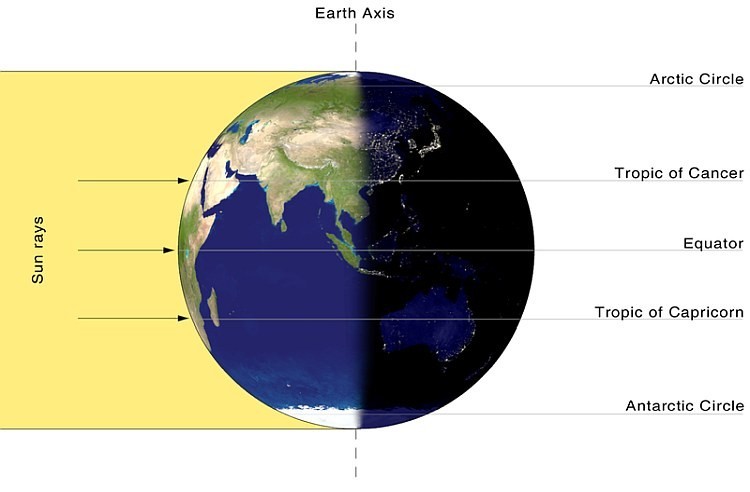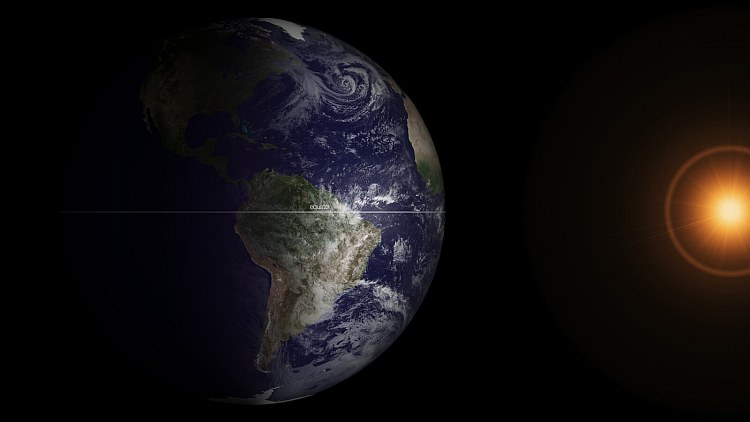What are equinoxes? What causes these astronomical events? Find out how they affect the seasons and hours of daylight on each planet.
Every six months, once in March and again in September, an equinox splits Earth’s day almost in half, giving us about 12 hours of daylight and 12 nights. March 20, 2020. Nature will once again bring us the vernal equinox, the time of year that heralds the summer season in the northern hemisphere and the winter season in the southern hemisphere. Then, on September 23, the autumnal equ inox will signal the arrival of winter for the north and the beginning of summer for the southern part of the world. Enjoy this post prepared with the online magazine Venus and Mars.
Also check out the days calculator
What does the equinox mean?
Our planet normally orbits the sun around an axis that is tilted by 23.5 degrees, meaning that the hemispheres exchange, receiving more heat from the sun. Twice a year, the Earth’s orbit and its axial tilt combine so that the sun is just above the equator, casting a dividing line between the light and dark parts of the planet – the so-called terminator or twilight zone – across the north and south Poles.

The terminator does not perfectly divide the planet into darkness and light; Earth’s atmosphere tilts the sunlight by 37 miles (60 kilometers), which is equal to half a degree. This means that one half of the planet is still slightly more illuminated than the other, even during the equinoxes.
Earth is not the only planet to experience equinoxes: every planet in our solar system has them . In 2009. Cassini probe in orbit around Saturn captured an equinox on the ringed planet .As on Earth, equinoxes occur every six months on Saturn, but that equals 15 years on Earth, making the Cassini photo shoot a unique event.
When is the next vernal equinox – 2021?
The vernal equinox, is equivalent to the date of the first day of spring – from now on, the northern hemisphere will receive more sunlight than the southern hemisphere. Below are the dates and times of the equinoxes from 2000-2025.

Spring equinox 2024 – March 20
Vernal equinox 2024 – date of astronomical spring.
The vernal equinox means that the Sun will illuminate more strongly the northern hemisphere, where we are, for half a year. The moment of the vernal equinox marks the beginning of astronomical spring in a given hemisphere. In 2022, the beginning of spring, or the March equinox, will take place on Sunday, March 20 at 4:32 pm.
Spring solstice: the first day of spring in 2023
The phenomenon of the spring equinox in 2024 will take place on Monday, March 20 at 10:24 p.m. The sun passes through the point of the ram, and the sun’s rays fall more strongly on the northern hemisphere. The date of astronomical spring does not coincide with the calendar date, which falls on March 21. However, as a result, the seasons can be celebrated doubly. During the solstice, day and night last the same amount of time, and then each successive day gets longer and longer until the summer solstice in June. The next equinox of the year is the autumnal equinox. The vernal equinox and autumnal equinox are the times when the sun’s rays fall on the equator at right angles.
The significance of the equinoxes in ancient cultures
Ancient cultures have tracked the equinoxes in various ways over the millennia. From built monuments such as the pyramids, to stone engravings that acted as calendars, to churches that incorporated the sun into their architecture, civilizations marked the passage of the sun and the seasons with great accuracy by studying the angle of the sun’s rays, among other things.

Some cultures still celebrate the equinox today, such as the Lakota tribe of the American Midwest. The Lakota connect the earth with the sky by making tobacco from the red willow tree, which matches the constellation Dried Willow, where the sun rises on the spring equinox. They smoke this sacred tobacco during a ceremony that marks the return of longer days.
And during the Stonehenge equinox ceremony in England, druids, pagans and anyone else who wants to join in gather to watch the sun rise over the ancient stones.
Slavs and magic on the day of astronomical spring
In Slavic mythology, the spring equinox brought farewell to the mistress of winter and death to Marzanna. Which is sometimes burned and sometimes drowned – this tradition is still cultivated from time to time in various open-air museums. The vernal equinox for the Slavs (and for us today) is a symbolic transition from winter to spring – it occurred during the Jary Gods, a celebration in honor of the god Jaryn. This was accompanied by various rituals – related to nature, which had a special value for the ancient people, especially since it often posed great challenges. During the Jary Gods, people tried to frighten nature and somehow win it over – to show it their authority. This was done in various ways during the Marzanna melt itself: instruments were played unrhythmically, loudly shouted. Young people would move to the forest, men would light a bonfire on the hills to carry the light that would bring life-giving spring and warmth, thus giving up the frost and cold. In addition, such customs also had a practical use – the noise was used to scare away wild animals that were looking for food after the winter and were getting closer to homes. Other, and at the same time very familiar to modern people customs associated with the arrival of spring, is the painting of eggs. Egg shells were colored using onion shells, tree bark, fresh shoots or simply dipped in wax and drew a design on it. Interestingly, the custom originated with the Persians, who used Easter eggs to celebrate Nowruz – or the arrival of the new year.

The spring equinox according to National Geographic
More information about the equinox and the sun’s journey through the year
Sources:
- https://www.nationalgeographic.com/science/space/equinoxes/
- https://www.flickr.com/photos/gsfc/
- https://pl.wikipedia.org/wiki/R%C3%B3wnonoc






